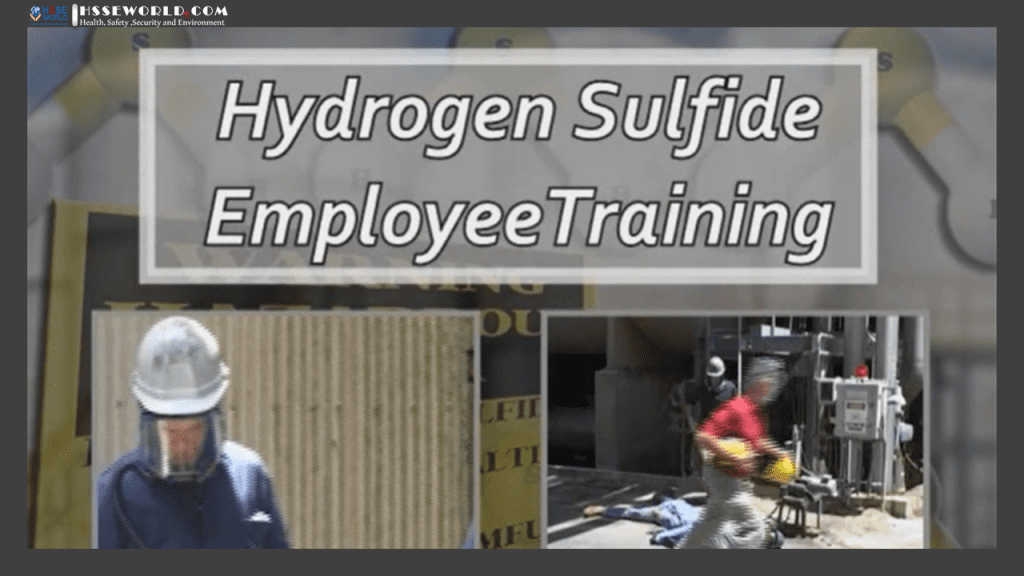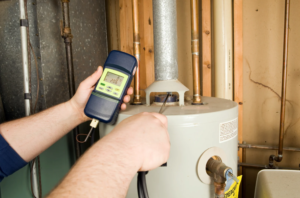Video: Hydrogen Sulfide Employee Training
12 min readEmployees can work safely in areas where the potential of hydrogen sulfide exists by following their organization’s Hydrogen Sulfide Contingency Plan; knowing how and when to use respiratory protection, and knowing the meaning of their facility’s hydrogen sulfide warning sounds and signals. This program reviews these three key issues and many other precautions that protect employees from H2S exposures when followed.
- What the dangerous characteristics of hydrogen sulfide are.
- What the symptoms of H2S exposure are.
- How warning devices and monitoring systems are used to notify employees of hydrogen sulfide levels.
- How to safely evacuate an area where hydrogen sulfide has been released.
( for more learning watch the Video Below )

Background
- Hydrogen sulfide is a deadly substance found in many workplaces. Understanding and controlling the hazards it presents is literally a matter of life and death.
- Your organization’s hydrogen sulfide contingency plan contains detailed information designed to control the hazards of hydrogen sulfide.
- Included in this plan will be a description of engineering controls, worker training requirements, protective equipment, gas monitoring devices and procedures, safe work practices and emergency evacuation and rescue plans—all designed to keep you safe from the harmful effects of hydrogen sulfide.
- You should always remember, the most important aspect of hydrogen sulfide safety is to take your training seriously and maintain a commitment to your own safety at all times.
Characteristics of hydrogen sulfide
- Hydrogen sulfide is a highly toxic, colorless gas that is heavier than air. Because it is heaver than air it will settle into low lying areas, creating a hazard if left undetected.
- Hydrogen sulfide is formed when two hydrogen atoms bond to an atom of sulfur. The chemical expression for this is h2s. H2s is another name for hydrogen sulfide. Besides h2s, hydrogen sulfide is also referred to as dihydrogen sulfide, hydrosulfuric acid, sulfuretted hydrogen as well as nicknames such as rotten egg gas, swamp gas, devil’s breath and stink damp, just to name a few.
- At low concentrations, hydrogen sulfide has an unpleasant odor similar to rotten eggs. As concentrations increase, its smell may turn very sweet, but you can never depend on detecting this odor for your safety.
- One reason hydrogen sulfide is so dangerous is that it can paralyze your sense of smell. This is called olfactory fatigue and it can occur very rapidly, especially at higher concentrations. Without proper air monitoring equipment, workers may be unaware they are being exposed to hydrogen sulfide.
- Hydrogen sulfide is found in nature as a byproduct of decomposing organic matter. It often develops in oxygen- depleted environments such as swamps and polluted waters.
- Hydrogen sulfide can also occur naturally as a component in natural gas, volcanic gases, sulfur deposits and petroleum. This is why protecting workers from hydrogen sulfide is so critical to safe petrochemical and drilling operations.
- Hydrogen sulfide also exists in many industrial processes, often as a byproduct or waste material.
( know more about H2S Gas and how to handle its Emergency)
Symptoms of exposure
- Concentrations of hydrogen sulfide are measured in parts per million. This is a measurement of how many molecules of hydrogen sulfide are present for every million molecules of air.
- The inhalation of hydrogen sulfide gas is the most common method of exposure. At concentration levels up to 10 parts per million, exposed workers may experience irritation of the eyes, nose and throat.
- Extended exposure over several hours can result in what is called “gas eyes” or “sore eyes,” with symptoms of burning, scratchiness and tearing.
- As hydrogen sulfide concentrations increase to between 10 and 50 parts per million, exposed workers may begin to experience headaches, dizziness and coughing. Nausea and vomiting may also occur at these concentrations.
- Exposure at levels between 50 and 100 parts per million can result in the onset of conjunctivitis and respiratory tract irritation after a one-hour exposure.
- Conjunctivitis is the irritation and swelling of the membrane of the eye lids, which results in intense tearing, blurring of vision, light sensitivity and a gritty, scratchy feeling.
- One hundred parts per million is also the idlh level for hydrogen sulfide. This level, established by the national institute of occupational safety and health, niosh, is the level at which you may suffer immediate, serious and irreversible damage from exposure. Idlh stands for immediate danger to life and health.
- Exposure at this level can lead to a loss of the sense of smell within two minutes and altered respiration and drowsiness can occur after 15 minutes. These symptoms will worsen with length of exposure.
- As concentration levels reach 500 to 700 parts per million, an exposed worker can lose consciousness and die in 30 to 60 minutes if not removed to fresh air and given proper medical treatment.
- When exposed to concentrations of hydrogen sulfide over 700 parts per million, unconsciousness can be very rapid and death will occur in a matter of minutes.
- Hydrogen sulfide is classified as a chemical asphyxiant; chemical asphyxiants reduce the body’s ability to absorb, transport or utilize inhaled oxygen. Overexposure causes death through biological suffocation. Another well-known chemical asphyxiant is carbon monoxide.
- Hydrogen sulfide in the bloodstream also affects the nervous system and at high concentrations can affect muscle coordination and the portion of our brain that controls breathing.
- After small to moderate levels of exposure, persons removed to fresh air normally recover with no lasting effects; however eye irritation and pain may persist for several days.
- Keep in mind that the various symptoms of exposure and the speed of their onset can be affected by factors such as frequency of exposure, body mass, overall physical condition, age and the influence of drugs and alcohol.
The Permissible Exposure limit
- The federal occupational safety and health administration, osha, limits workplace exposure to hydrogen sulfide in its regulation 1910.1000-air contaminants.
- Table z-2 of this regulation lists the “acceptable ceiling concentration” for hydrogen sulfide as 20 parts per million. A ceiling concentration is not a time-weighted average exposure, but rather a maximum level at any time in an eight-hour work shift.
- Table z-2 also lists an “acceptable maximum peak” above the “acceptable ceiling concentration” of 50 parts per million for a duration of 10 minutes if no other measurable exposure has occurred.
The threshold limit value
- The threshold limit value (tlv) is the maximum average concentration over an eight-hour period for which no harmful effects will occur. The source for threshold limit values is the american conference of governmental and industrial hygienists, the acgih. The acgih has no regulatory authority.
- Prior to 2010, the acgih threshold limit value for hydrogen sulfide was 10 parts per million. In 2010, the acgih reduced the threshold limit value to one part per million.
The short-term exposure limit
- The acgih has also established a short-term exposure limit, or stel, for hydrogen sulfide. A short-term exposure limit is the maximum average concentration over a 15-minute period for which no harmful effects will occur.
- Prior to 2010, the acgih short-term exposure limit was 15 parts per million. In 2010, the acgih reduced the short-term exposure limit to five parts per million.
- The ACGIH recommends that a minimum of 60 minutes should elapse between each short-term exposure and no more than four short-term exposures should occur in any one day.
- Your organization has an exposure control plan which protects you from hazardous exposure to hydrogen sulfide. The concentration of hydrogen sulfide which triggers protective action at your facility will, at a minimum, be equal to the current federal osha permissible exposure limit and may be even lower if based on the acgih recommendations or a more stringent state or local regulation.
( Read more about Workplace exposure limits )
Engineering controls
- Once hydrogen sulfide concentrations reach the permissible exposure limit defined in your facility’s contingency plan, actions must be taken to reduce employee exposure.
- When possible, implementing engineering controls is always the first choice to reduce employee exposure to hydrogen sulfide.
- For example, a work area may be enclosed to maintain a safe atmosphere or ventilation systems may be installed to maintain h2s concentrations at safe levels.
- Hydrogen sulfide gas may also be collected and burned or “flared.” When hydrogen sulfide is burned, one byproduct is sulfur dioxide.
- Hydrogen sulfide is often contained in pipes and routed away from work areas.
Respiratory protection
- If the company cannot reduce the concentration of hydrogen sulfide to less than the permissible exposure limit, exposed workers will be required to wear respiratory protection.
- For concentrations of hydrogen sulfide below the idlh level of 100 parts per million, a full-face, air-purifying respirator with chemical cartridges rated for hydrogen sulfide may be used.
- For concentrations above 100 parts per million or when entering an area of unknown concentration levels an scba or sar is required.
- SCBA stands for “self-contained breathing apparatus” and requires that the user carry a limited air supply on their back.
- SAR stands for “supplied-air respirator.” This type of respirator utilizes purified air supplied from a hose connected to a compressor.
- Employees who may be required to wear a respirator or breathing apparatus must undergo a medical evaluation by a licensed physician who will determine your ability to wear a respirator effectively.
- Annual fit-testing is also required to ensure that each employee can achieve a proper fit in the type of respirator they may be asked to wear.
- Facial hair and sideburns may prevent a proper seal. For this reason, many companies have facial hair restrictions.
- If you may be required to wear a respirator, you will receive specific training on the types of respirators used at your facility, their locations and the specific situations which require their use.
- When donning a respirator, a proper seal between the face piece and your face must be established for the respirator to function properly. A user-seal check must be performed each time you put on a respirator to ensure a good seal has been established.( Breath Safely: The Proper Use of Respiratory Protection )
Importance of using correct chemical cartridges
- When using a chemical cartridge respirator, be aware that each cartridge is designed for a specific chemical. For example, you must have the correct cartridge for hydrogen sulfide for your respirator to be effective.
- Also, be aware that each chemical cartridge has a usable service life. Cartridges must be changed out before the end of their service life to prevent “break through.” Break through occurs when the cartridge is no longer effective and the user is exposed to the chemical.
- This can be particularly dangerous in a hydrogen sulfide environment, since the user may be unable to detect that exposure has occurred.
SCBA Air Supply levels
- A traditional scba will have a 30-minute air supply. It may be used for normal work in hydrogen sulfide areas or for rescue operations.
- A low-air alarm will sound when 25 percent of the air supply remains. When this occurs, you must leave the area immediately.
- Some SCBA’s are designed for escape only and only have a five-minute air supply. These are only to be used for an escape and must not be used for normal work or rescue.
- Some types of supplied-air respirators also have a secondary air tank to be used for escape. Again, only use this air supply to escape; do not use it for regular work or rescue.
- If you have any questions regarding the respiratory equipment you may be required to use or have any doubts about your ability to use it properly, don’t hesitate to ask your supervisor for assistance. Your life may one day depend on the proper use of respiratory protection.
Confined space entry
- Hydrogen sulfide is often present in confined spaces such as manholes, pits, sewers and vessels. Because hydrogen sulfide is heavier than air, it will settle to the bottom of these types of spaces.
- Unprotected workers who enter such spaces often reach the bottom and then are overcome by hydrogen sulfide and are unable to escape. To make matters worse, this type of situation often leads to multiple fatalities as other unprotected workers rush into the space to help; one study found that 21 percent of fatal hydrogen sulfide incidents involved multiple fatalities.
- Because of the dangers involved in entering confined spaces, only those employees trained and authorized may enter a confined space. Your company maintains a written confined space entry program that details the safe work practices required to enter each confined space and establishes a written permit entry system to ensure that all hazards have been controlled. ( Video: Employee safety in confined spaces )
Warning devices & monitoring systems
- Some work areas always have the possibility of a release of hydrogen sulfide above the permissible exposure limit.
- All areas with the potential for h2s will also have various devices and monitoring systems to detect the presence of the gas. In some cases, fixed-point monitors will be installed, while in other areas portable or handheld monitors may be used.
- In either case, these monitors will be calibrated to sound a warning when hydrogen sulfide levels reach the predetermined action levels in your facility’s hydrogen sulfide contingency plan. Many facilities utilize a two- level warning system.
- For example, one type of warning may be given to alert workers when hydrogen sulfide levels approach the permissible exposure limit or a limit specified by your organization. This type of warning may require nonessential workers to leave the area and essential workers to don appropriate respiratory protection.
- Should hydrogen sulfide levels go even higher, such as approaching the idlh level or other level specified by your organization, an evacuation warning may be given.
- Make sure you understand what visual and/or audible signals are used at your facility and their meaning.
Safe evacuation procedures
- If an evacuation alarm sounds, you should move upwind swiftly and if possible, uphill. Avoid low lying areas as hydrogen sulfide is heavier than air and will collect in these types of areas.
- If you are not wearing a respirator when an evacuation alarm sounds, hold your breath as long as possible while evacuating. If you have access to a proper respirator, quickly put it on.
- Areas with the potential for hydrogen sulfide releases will have a visible wind indicator such as a wind sock or streamers to help determine wind direction.
- These areas should also have more than one escape route to facilitate a safe evacuation. Employees working in hydrogen sulfide-prone areas should remain conscious of wind direction and escape routes.
- Evacuating employees must report to a designated briefing area so each person can be accounted for. Briefing areas should also be set up at least 250 feet away and upwind from hydrogen sulfide-prone areas. Briefing areas will have prominent signs that can be easily seen by employees.
- Remember that a high percentage of hydrogen sulfide deaths involve multiple fatalities. During a hydrogen sulfide incident, never attempt to assist a fallen worker unless you are wearing appropriate respiratory protection and are trained to assist.
- In this situation, being a good samaritan can easily kill you. The same concentration of hydrogen sulfide that quickly overcame your co-worker will just as quickly overcome you.
- Instead, head straight to the briefing area and report the location of your fallen worker. A properly-outfitted and trained rescue team can then retrieve the fallen worker and quickly get him to fresh air and medical attention.
- After a release of hydrogen sulfide, do not return to the area until it has been monitored and rendered safe to enter. (Photo of the day: Emergency preparedness in the workplace)
Other safety tips for working in h2s-prone areas
- Never work alone in these areas. Use a buddy system. As part of the buddy system, you should always know where your buddy is and be mindful of his or her safety.
- Hydrogen sulfide is flammable with a flashpoint of just 500 degrees fahrenheit. Do not smoke in any hydrogen sulfide area and do not perform any type of welding or cutting operations without first controlling the hazards and obtaining a hot work permit.
- Maintain an awareness of wind direction and work upwind of potential hydrogen sulfide sources whenever possible.
- Some facilities use a color-coded system of warnings so workers approaching a potential hydrogen sulfide area will have knowledge of the current conditions. If your facility uses such a system, make sure you understand the meaning of each color-coded signal.
Watch The Video :
More videoes
- Creating safety in welding operations
- Video: Ladder Safety-A Practical Approach
- Video: Stored Energy
- Video: Hydrogen Sulfide Employee Training
- Video: Protecting our sight
- Video: Supported Scaffolding Safety
- Video: Preventing Fires During Hot Work Operations
- Video: Lockout – Tagout Safety Training
- Video: Preventing Heat-Related Illnesses
- Video: Your Personal Fall Arrest System: Surviving the Fall
- Accident Investigation for Everyone
- Video: Fire Prevention & Response
- RCRA Hazardous Waste Final Rule: The E-Manifest System & Other Key Revisions
- Video: Avoiding line of Fire: Safety Moment#36
- Video: Employee safety in confined spaces
- Video: Aerial Work Platform Safety: Safety Moment#35
- Tips to Avoid Standstill Accidents: Safety Moment#33
- Common Causes of the workplace incident: Safety Moment#32
- Evaluating the Effectiveness of Leading Indicators and Developing High-Impact for safety
- Machinery Guarding: Safety Moment#31
- Electrical Safety While Working From Home: Safety Moment#30
- Dehydration in cold weather
- Lifting Calc 3: Safety APP
- Video: Working safely Near powerlines -Safety Moment#26
- Video: Winter’s Hidden Hazard -Safety Moment#25
- Video: Isocyanates Exposure -Safety Moment#24
- Video: Electrical Safety Awareness -Safety Moment#23
- Safety Flash: Laborer Dies After Footing Collapse – North Carolina
- Risk Assessment Training and Application tool
- Falls from heights :Video-Safety Moment #14
- The Golden safety rules :Video-Safety Moment #12
- Incident Report Form
- Video:Accident Investigation-1
- Slips,Trips and Falls checklist
- scaffold-Power fatility
- Nitrogen Hazard lead to Fatal Accident




119 thoughts on “Video: Hydrogen Sulfide Employee Training”